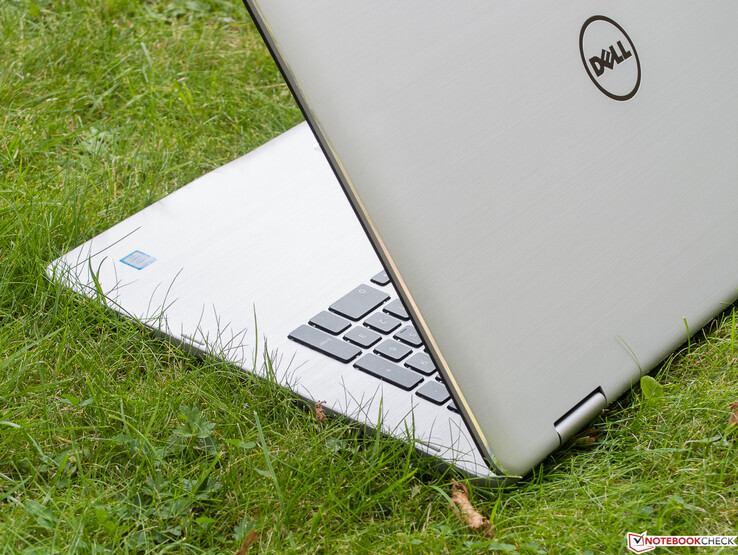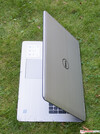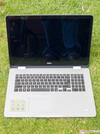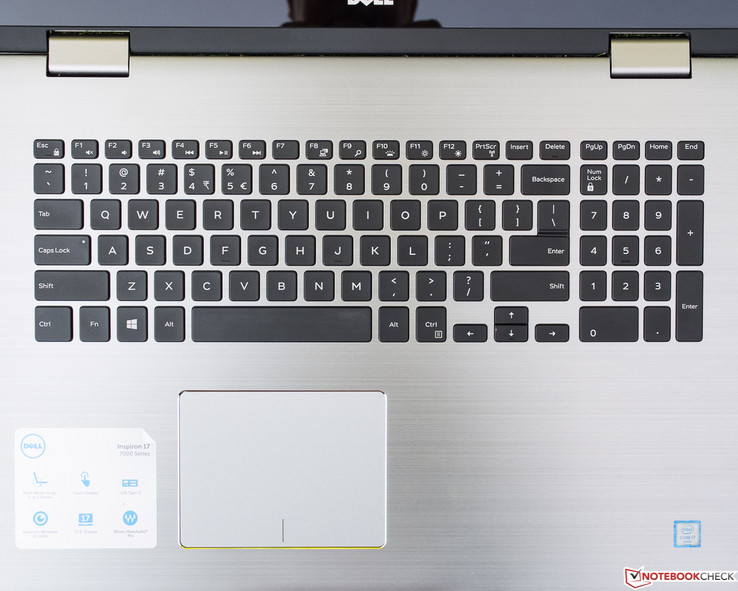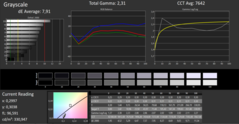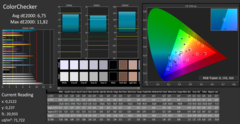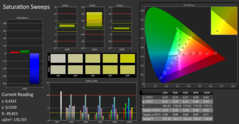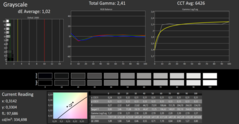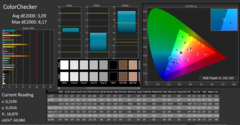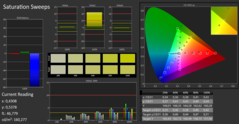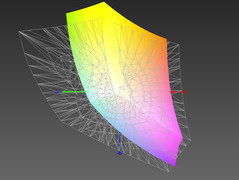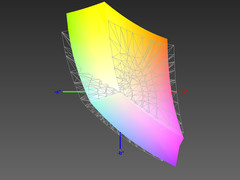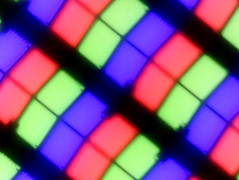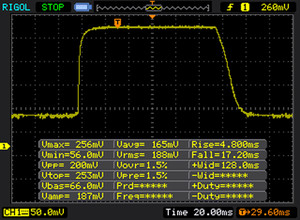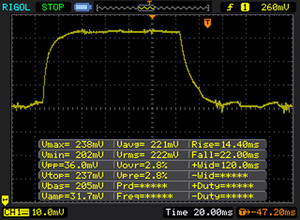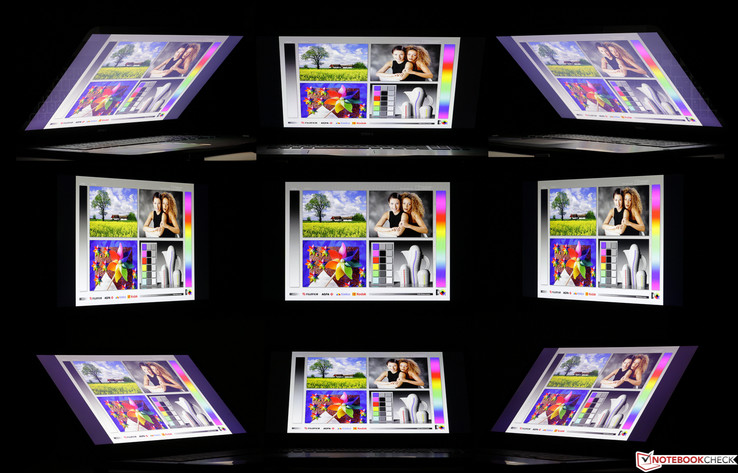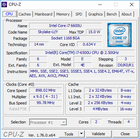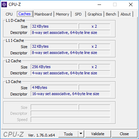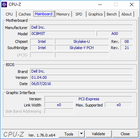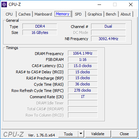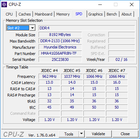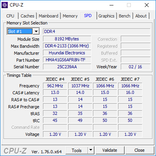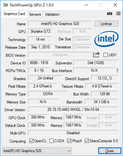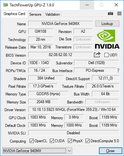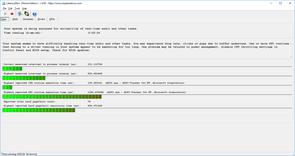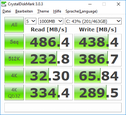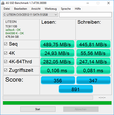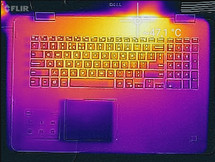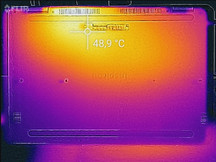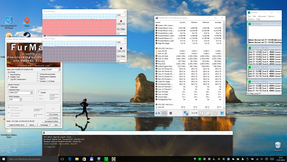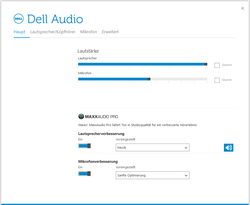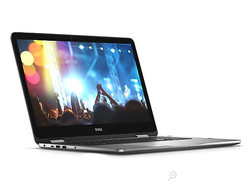Dell Inspiron 17 7778 Convertible Review

For the original German review, see here.
Dell's 17-inch Inspiron 17 7778 convertible has a very unconventional size for this category. To be more precise, it is so far the only device in our database. Two models were listed on the 17 2-in-1 7000 lineup webpage at the time of testing. Only their storage devices were different. The model with the code CN77701 and priced at an RRP of 1179 Euros (~$1316) is equipped with a 128 GB SSD plus a traditional 1 TB hard drive. Dell code names our review sample as CN77702, which is equipped with a 512 GB SSD and is priced at 1099 Euros (~$1227).
Intel's Core i7-6500U (2x 2.5 - 3.1 GHz, Hyperthreading, TDP: 15 W) powers the device. A generous 16 GB of DDR4 support it, and a dedicated mid-range graphics card in the form of the latest Nvidia GeForce 940MX with 2 GB of dedicated memory is responsible for video output. The glossy Full HD touchscreen is based on IPS technology. Windows 10 Home is preloaded. Apparently, Dell does not offer any individual hardware configuration options for either model. In addition to office users, the new Inspiron is also aimed at casual gamers who do not have high expectations from the graphics quality.
The 360-degree hinge allows using the convertible in different modes. In addition to the traditional laptop mode, the tablet mode is particularly interesting where the base is folded by 360 degrees and the automatically disabled keyboard is then on the underside. With a weight of almost 2.8 kg (~6.2 lb), it is virtually impossible to hold the device with only one hand, and thus it will probably be usually used on a table. In the author’s opinion, it is a quite successful implementation of tablet mode for the use of Windows 10.
As might be supposed, Dell does not have any direct convertible predecessors in this size. Therefore, we have to inevitably use three 15-inch convertibles for comparison. Since the options here are also limited, some devices primarily only match the price of the Inspiron 17 7778 partially. We have added a conventional laptop from the same price range as the review sample, which is equipped with the same CPU but a GeForce 940M instead.
These contestants join the battle:
Case
We could not determine whether the casing is (partially) made of metal. In any case, the shiny silver-matte brushed metal finish of the lid's back and the base's upper side give a metal-like impression. Fingerprints are virtually invisible - very nice. The base's center front is lowered slightly. Four spacers are on the sides to prevent the screen from lying on the black, not lowered keyboard when closed. As with touchscreens, the panel almost covers the black display bezel completely. Overall, the design is quite plain. Besides the classy surfaces, the strikingly rounded edges, Dell's logos, and a kind of trim strip on the lid's upper edge are the visual highlights.
The laptop's very pressure resistant lid cannot be opened with one hand thanks to the tightly pulled hinges. Nevertheless, the convertible's rocking behavior in the stand mode is less than ideal. The display wobbles for a few seconds after being touched. Fortunately, the review sample's display unit is not as sensitive as that of the smaller Inspiron 13 7359. The base resisted our warping attempts to quite some degree, and only produced very quiet, not unhealthy sounding noises. Since the build is impeccable, we are dealing with an overall good and solid casing with nice surfaces.
Connectivity
Only the most essential interfaces are installed. Since an Ethernet port is absent, the user is dependent on Wi-Fi. Only two of the three USB ports support the fast 3.0 standard. As with Dell's smaller Inspiron 13 7359-4839 model, Dell has managed to position the interfaces quite ergonomically in the rear areas of the sides. Some special, convertible-related features should be mentioned: the power button is on the front right, followed by the volume control. Dell has dispensed with a stylus for this model.
SD Card Reader
Although transfer speeds of 23 and 26 MB/s are not the absolute worst rates, they are still weak and imply that the card reader is only connected via USB 2.0. The only rival in the test that does not suffer from this limitation is HP's Envy 15. We used our Toshiba Exceria Pro SDXC 64 GB UHS-II reference card for the measurements.
| SD Card Reader | |
| average JPG Copy Test (av. of 3 runs) | |
| HP Envy 15-w103ng x360 | |
| Dell Inspiron 17 7778 | |
| Dell Inspiron 15 5568 | |
| Acer TravelMate P278-MG-76L2 | |
| maximum AS SSD Seq Read Test (1GB) | |
| HP Envy 15-w103ng x360 | |
| Acer TravelMate P278-MG-76L2 | |
| Dell Inspiron 15 5568 | |
| Dell Inspiron 17 7778 | |
Communication
The Inspiron is equipped with Intel's Wireless-AC 3165 module with only one antenna (MIMO 1x1) for wireless connections. A gross data rate of 433 Mbit/s can normally be achieved in the low-interference 5 GHz band. In addition to the latest ac standard required for this, the module also supports a/b/g/n and Bluetooth 4.2 (updating the driver might be necessary). There were no reception problems in the author's personal test setup, but it did not stand out with a particularly high range. Dell does not offer mobile wireless modules for this lineup.
| Networking | |
| WiFi Speed Client 1m | |
| WiFi Speed Server 1m |
Accessories
Nothing but the mandatory power supply and cables, a quick start guide and the usual safety notes is included in the simple box. This video shows a smaller convertible by Dell, but it conveys a good impression of the different modes and shows Dell accessories, such as external speakers and a bag that would function with any other laptop. The 13-inch model in the video has a stylus that is absent for the review sample.
Maintenance
Ten screws have to be released and the base plate has to be removed before the innards can be accessed, which does not seem like a problem. Unfortunately, the battery cannot be removed from the outside. When looking at the recently tested Dell Inspiron 13 7359-4839 that has a similar base plate, most components should be easy to reach after the simple dismantling.
Warranty
Our review sample was actually intended for the British market and the Inspiron comes with a one-year pick-up and repair service called "CAR Service"; details can be found here. In addition to the standard two-year warranty with accidental damage protection, private users can upgrade and extend the warranty for a charge via Dell's service plans.
Input Devices
Keyboard
We cannot praise the black chiclet keyboard (British layout) excessively. Since the main field's width is only a few millimeters smaller than a standard desktop keyboard, the key sizes and spacing are acceptable. On the other hand, the unnecessarily scaled down number pad is not standard, and thus users with larger hands will probably not benefit from it.
The keyboard produces a spongy typing feel with moderate feedback with a low drop, not really crisp pressure point and, in the tester's opinion, too soft a stroke. The flat keys' lettering is quite legible and can be backlit in two levels. The layout corresponds largely to the standard and will not need getting used to. All keys, including the larger ones, produce only a quiet noise that is not disturbing.
Touchpad
We liked the ClickPad without visibly separated keys better. The lightly roughened, very large surface is touch-sensitive far into the edges. The accuracy and responsiveness are beyond reproach, and even fast movements are implemented. Drag & drop via double-tap always functioned reliably. Three-finger gestures can only be configured via Windows 10 tools due to the lack of dedicated software. Both mouse replacement keys with a short drop offer quite noticeable and audible feedback thanks to their crisp pressure points.
Touchscreen
The gliding qualities of the screen's sleek surface are impeccable with dry fingers. However, they are not ideal with slightly moist fingers (which is almost always the case in the summer) because the fingers stick slightly to the surface. Up to ten fingers at a time are detected. The accurate and lag-free responding screen is touch-sensitive into the outermost corners and also implements fast movements.
Display
Dell relies on an IPS-based Full HD touchscreen that has a glossy surface (for cleaning purposes). The approximately 2 million dots distributed over 17.3 inches equates to a somewhat outdated pixel density of 127 PPI. Users with good eyesight might find the actually impeccably sharp reproduction a bit pixelated at close proximity. On the other hand, fonts and icons have a pleasant size in the preset 100% scaling. Users who need a higher pixel density will find this in all 15-inch convertibles in the test due to their smaller screen size. HP's Spectre 360 even serves with a 4K panel with 282 PPI. Other screens are not offered.
Standard-sized convertibles will certainly be used more frequently in changing and sometimes unfavorable light conditions than the review sample. Therefore, we apply the criteria that we use for conventional laptops here. The maximum brightness of 314 cd/m² (center) is impressive in any case, and it is distributed evenly. Only the TravelMate laptop exceeds this. A too dark reproduction is virtually excluded indoors. We will look at the device's outdoor behavior below. Backlight bleeding is visible at the upper edge in a completely black image.
| |||||||||||||||||||||||||
Brightness Distribution: 87 %
Center on Battery: 334 cd/m²
Contrast: 1090:1 (Black: 0.3 cd/m²)
ΔE ColorChecker Calman: 6.75 | ∀{0.5-29.43 Ø4.78}
ΔE Greyscale Calman: 7.91 | ∀{0.09-98 Ø5}
86% sRGB (Argyll 1.6.3 3D)
57% AdobeRGB 1998 (Argyll 1.6.3 3D)
63.1% AdobeRGB 1998 (Argyll 3D)
86.3% sRGB (Argyll 3D)
67.4% Display P3 (Argyll 3D)
Gamma: 2.31
CCT: 7642 K
| Dell Inspiron 17 7778 LG Philips LGD 0513 / 173WF4, , 1920x1080, 17.3" | HP Spectre x360 15-ap012dx 3840x2160, 15.6" | Dell Inspiron 15 5568 AU Optronics B156HW01 V0, , 1920x1080, 15.6" | HP Envy 15-w103ng x360 LG Philips, , 1920x1080, 15.6" | Acer TravelMate P278-MG-76L2 AUO B173HTN01.1 (AUO119D), , 1920x1080, 17.3" | |
|---|---|---|---|---|---|
| Display | -1% | -39% | -36% | 4% | |
| Display P3 Coverage (%) | 67.4 | 62.8 -7% | 38.04 -44% | 39.97 -41% | 68.8 2% |
| sRGB Coverage (%) | 86.3 | 88.2 2% | 57.1 -34% | 59.8 -31% | 90.6 5% |
| AdobeRGB 1998 Coverage (%) | 63.1 | 63.9 1% | 39.3 -38% | 41.32 -35% | 66.3 5% |
| Response Times | -9% | -9% | -15% | -10% | |
| Response Time Grey 50% / Grey 80% * (ms) | 36 ? | 32.8 ? 9% | 42 ? -17% | 37 ? -3% | 41 ? -14% |
| Response Time Black / White * (ms) | 22 ? | 28 ? -27% | 22 ? -0% | 28 ? -27% | 23 ? -5% |
| PWM Frequency (Hz) | 1000 ? | ||||
| Screen | -1% | -1% | -17% | -21% | |
| Brightness middle (cd/m²) | 327 | 298 -9% | 266 -19% | 208 -36% | 362 11% |
| Brightness (cd/m²) | 314 | 295 -6% | 249 -21% | 205 -35% | 344 10% |
| Brightness Distribution (%) | 87 | 88 1% | 85 -2% | 80 -8% | 84 -3% |
| Black Level * (cd/m²) | 0.3 | 0.57 -90% | 0.26 13% | 0.26 13% | 0.57 -90% |
| Contrast (:1) | 1090 | 523 -52% | 1023 -6% | 800 -27% | 635 -42% |
| Colorchecker dE 2000 * | 6.75 | 4.43 34% | 4.98 26% | 6.97 -3% | 9.54 -41% |
| Colorchecker dE 2000 max. * | 11.82 | 6.62 44% | 11.82 -0% | 16.11 -36% | |
| Greyscale dE 2000 * | 7.91 | 2.45 69% | 2.68 66% | 7.37 7% | 10.39 -31% |
| Gamma | 2.31 95% | 2.45 90% | 2.27 97% | 2.34 94% | 2.55 86% |
| CCT | 7642 85% | 6326 103% | 6583 99% | 6823 95% | 11093 59% |
| Color Space (Percent of AdobeRGB 1998) (%) | 57 | 57.2 0% | 36 -37% | 38 -33% | 59 4% |
| Color Space (Percent of sRGB) (%) | 86 | 87.8 2% | 57 -34% | 59 -31% | 90 5% |
| Total Average (Program / Settings) | -4% /
-2% | -16% /
-10% | -23% /
-21% | -9% /
-15% |
* ... smaller is better
A black value of just 0.3 cd/m², which is only marginally undercut by Dell's 15-inch device and HP's Envy, in conjunction with the very good brightness offer the best preconditions for a high contrast ratio. With a superb 1090:1, it also takes the first place among the comparison devices. The x360 convinces the least; although it is almost as bright as the review sample, its much higher black value reduces the contrast ratio.
DeltaE rates describe the color deviation from the standard and tend to be lower than 3 in good IPS panels. At least, HP and the Inspiron 15 manage this in the grayscale levels, but our review sample clearly misses this mark, which is important for image editors. Calibrating and profiling (color profile linked in the box above) improve the situation considerably and eliminate the striking pinkish tint. The TN panel in Acer's laptop does a much worse job here. Finally, we would like to look at the color space. Hobby image editors will want near or full sRGB coverage. None of our contestants achieve this, and unfortunately, the Inspiron 17's 86% is not sufficient for these purposes.
Despite the high brightness, outdoor use is not very practical, at least on sunny days with the ever present reflections. Working with the device is conditionally possible when the user can make sure that bright light does not fall on the screen from behind and above, as in the right screenshot (doorway). Outdoor use will still cause some problems in the tablet mode even in cloudy conditions.
Display Response Times
| ↔ Response Time Black to White | ||
|---|---|---|
| 22 ms ... rise ↗ and fall ↘ combined | ↗ 5 ms rise | |
| ↘ 17 ms fall | ||
| The screen shows good response rates in our tests, but may be too slow for competitive gamers. In comparison, all tested devices range from 0.1 (minimum) to 240 (maximum) ms. » 47 % of all devices are better. This means that the measured response time is similar to the average of all tested devices (20.2 ms). | ||
| ↔ Response Time 50% Grey to 80% Grey | ||
| 36 ms ... rise ↗ and fall ↘ combined | ↗ 14 ms rise | |
| ↘ 22 ms fall | ||
| The screen shows slow response rates in our tests and will be unsatisfactory for gamers. In comparison, all tested devices range from 0.165 (minimum) to 636 (maximum) ms. » 49 % of all devices are better. This means that the measured response time is worse than the average of all tested devices (31.6 ms). | ||
Screen Flickering / PWM (Pulse-Width Modulation)
| Screen flickering / PWM not detected | ||
In comparison: 53 % of all tested devices do not use PWM to dim the display. If PWM was detected, an average of 8118 (minimum: 5 - maximum: 343500) Hz was measured. | ||
It has become rare for clear color distortions from very tilted views or flat viewing angles (one level) as known from TNs to occur in an IPS panel. As for the still not entirely avoidable brightness and contrast loss, Dell's Inspiron 17 7778 is subjectively, in the midfield of modern screens. In practice, restrictions will be unlikely even in tablet mode. The other manufacturers in the test have recognized that an IPS panel is a must for convertibles.
Performance
Processor
No matter which of the latest and economical Skylake dual-cores with Hyperthreading the user opts for, the very measurable speed differences are usually not negligible in practice. The two physical cores are not enough for strongly parallelized software such as most up-to-date games, and only a fraction of commercial software benefit from the higher clock rates of i7 CPU such as the installed 6500U. The low ULV TDP of 15 watts is usually the performance limiting factor. At a base speed of 2.5 GHz, only a maximum of 3.1 GHz can be achieved (2 cores: 3.0 GHz). An Intel HD Graphics 520 without dedicated memory is integrated.
Apart from the named exceptions, enough power is available for most application scenarios, including the use of demanding software. Skylake can deal with DDR4 RAM for the first time, and it is present in the review sample alongside a generous 16 GB in dual-channel mode (2x 8). This is the best precondition for the CPU benchmarks in the form of Cinebench R15. Nevertheless, the multi-core benchmark scores are exactly on average with all measured i7-6500Us. However, the 7% difference compared to the first-place CPUs is lower than the 20% difference to the last-place CPUs. The clock rates range from 2.6 to 3 GHz so that we can confirm the contestant's good, but not perfect Turbo utilization. The scores do not change in battery mode.
System Performance
Thanks to the SSD, the clever Hyperthreading dual-core, the generous 16 GB of DDR4 RAM in dual-channel mode, and the dedicated graphics card, Dell's Inspiron 17 7778 is very responsive. Excessive multitasking does not cause any hiccups. Even programs that are not cached open quickly and can operate smoothly. The system also boots extremely fast.
Our Dell 17 has the strongest engine in the test field, and as expected, places itself up front in PCMark 8. The difference compared to most opponents, all with an SSD, are kept within tight limits although Dell's Inspiron 15 5568 is not equipped with a dedicated graphics card. We cannot explain why HP's Envy 15 falls so far behind in PCMark 8.
| PCMark 8 | |
| Home Score Accelerated v2 | |
| Dell Inspiron 17 7778 | |
| Dell Inspiron 15 5568 | |
| Acer TravelMate P278-MG-76L2 | |
| HP Envy 15-w103ng x360 | |
| HP Spectre x360 15-ap012dx | |
| Work Score Accelerated v2 | |
| Dell Inspiron 17 7778 | |
| Acer TravelMate P278-MG-76L2 | |
| Dell Inspiron 15 5568 | |
| HP Envy 15-w103ng x360 | |
| HP Spectre x360 15-ap012dx | |
| PCMark 8 Home Score Accelerated v2 | 3696 points | |
| PCMark 8 Work Score Accelerated v2 | 4572 points | |
Help | ||
Storage Device
The storage device is a 512 GB SSD by Lite-On that does not quite achieve the SATA 3 interface limit of a good 500 MB/s in sequential data transfer rates of most other SSDs in the test. Like the SanDisk model in HP's Spectre x360, the Lite-On SSD achieves slightly more than 30 MB/s in 4K read, which is important for OS and program starts.
We would rate the performance of the review sample's storage device as slightly above average. The most important thing in practice is that an SSD is present.
| Dell Inspiron 17 7778 Liteonit CV3-CE512 | HP Spectre x360 15-ap012dx Sandisk X300 SD7SN6S-256G-1006 | Dell Inspiron 15 5568 Toshiba THNSNK256GCS8 | HP Envy 15-w103ng x360 Samsung SSD PM851 256 GB MZNTE256HMHP | Acer TravelMate P278-MG-76L2 Lite-On CV1-8B256 | |
|---|---|---|---|---|---|
| CrystalDiskMark 3.0 | -4% | -8% | 2% | -4% | |
| Read Seq (MB/s) | 486.4 | 475.6 -2% | 458.6 -6% | 515 6% | 473 -3% |
| Write Seq (MB/s) | 438.4 | 425 -3% | 270 -38% | 240.7 -45% | 366.3 -16% |
| Read 512 (MB/s) | 232.8 | 258.4 11% | 397.4 71% | 391.3 68% | 329.4 41% |
| Write 512 (MB/s) | 386.7 | 318.9 -18% | 242 -37% | 240 -38% | 357.3 -8% |
| Read 4k (MB/s) | 32.3 | 35.48 10% | 19.88 -38% | 27.64 -14% | 30.83 -5% |
| Write 4k (MB/s) | 65.8 | 93 41% | 86.7 32% | 95.2 45% | 74.8 14% |
| Read 4k QD32 (MB/s) | 334.4 | 281.2 -16% | 275.3 -18% | 367.9 10% | 245.1 -27% |
| Write 4k QD32 (MB/s) | 289.5 | 138.7 -52% | 197.6 -32% | 239 -17% | 217.3 -25% |
Graphics Card
The dedicated, mid-range graphics card from the Maxwell generation is a relatively new Nvidia GeForce 940MX with 2 GB of dedicated storage. Unlike the otherwise almost identical 940M predecessor, the new model supports GDDR5 memory, which is also used here and is connected via a narrow 64-bit bus. The card supports DirectX 12 at Feature Level 11_0. Thanks to the GDDR5 memory, a 20% higher performance can be counted on compared with the 940M that is always equipped with a DDR3 RAM. The gaming benchmarks confirm this, but not in all games. Although the card can decode H.264 4K video material in the hardware, it can only render to external monitors at 30 Hz in full resolution due to the lack of HDMI 2.0. The low power consumption makes the 940MX suitable for smaller laptops starting at a size of 13 or 14 inches.
As expected, the 940MX in Dell's laptop surpasses the 940M (DDR3) in Acer's TravelMate by 13 to 29%; it is 15% in the 3DMark 11. The total 3DMark 11 score does not change in battery mode.
| 3DMark 11 - 1280x720 Performance GPU | |
| Dell Inspiron 17 7778 | |
| Acer TravelMate P278-MG-76L2 | |
| HP Envy 15-w103ng x360 | |
| Dell Inspiron 15 5568 | |
| HP Spectre x360 15-ap012dx | |
| 3DMark | |
| 1280x720 Cloud Gate Standard Graphics | |
| Dell Inspiron 17 7778 | |
| Acer TravelMate P278-MG-76L2 | |
| Dell Inspiron 15 5568 | |
| HP Envy 15-w103ng x360 | |
| HP Spectre x360 15-ap012dx | |
| 1920x1080 Fire Strike Graphics | |
| Dell Inspiron 17 7778 | |
| Acer TravelMate P278-MG-76L2 | |
| HP Envy 15-w103ng x360 | |
| HP Spectre x360 15-ap012dx | |
| 3DMark 11 Performance | 2867 points | |
| 3DMark Cloud Gate Standard Score | 7674 points | |
| 3DMark Fire Strike Score | 1748 points | |
Help | ||
Gaming Performance
When looking at the many benchmarks shown below this section, unfortunately the 940MX in the review sample cannot always convert the GDDR5 advantage confirmed in the synthetic benchmarks into more FPS. The frame rates sometimes even lag behind the DDR3 versions, but depending on the game and the processor in the comparison device, it could also be due to a CPU limitation on account of the only two physical cores of the i7 in the review sample.
The card often renders older 3D games such as "BioShock Infinite" or even "Battlefield 4" smoothly with some compromises. 1366x769 pixels and the medium preset are usually the ultimate in newer and/or especially demanding games. Isometric games, such as "FIFA 16" normally run smoothly in high or maximum setting, particularly since 40 FPS is not a must in this sector.
| Mirror's Edge Catalyst | |
| 1920x1080 High Preset AF:16x | |
| MSI CX72 6QD | |
| Dell Inspiron 17 7778 | |
| 1366x768 Medium Preset AF:4x | |
| MSI CX72 6QD | |
| Asus VivoBook X556UQ-XO076T | |
| Dell Inspiron 17 7778 | |
| Far Cry Primal | |
| 1920x1080 High Preset AA:SM | |
| Dell Inspiron 17 7778 | |
| MSI CX72 6QD | |
| Lenovo ThinkPad T560-20FH002RGE | |
| 1920x1080 Medium Preset AA:SM | |
| MSI CX72 6QD | |
| Dell Inspiron 17 7778 | |
| Lenovo ThinkPad T560-20FH002RGE | |
| Rise of the Tomb Raider | |
| 1920x1080 High Preset AA:FX AF:4x | |
| Dell Inspiron 17 7778 | |
| MSI CX72 6QD | |
| Lenovo ThinkPad T560-20FH002RGE | |
| Acer TravelMate P278-MG-76L2 | |
| 1366x768 Medium Preset AF:2x | |
| Dell Inspiron 17 7778 | |
| MSI CX72 6QD | |
| Lenovo ThinkPad T560-20FH002RGE | |
| Acer TravelMate P278-MG-76L2 | |
| Just Cause 3 | |
| 1920x1080 High / On AA:FX AF:8x | |
| MSI CX72 6QD | |
| Lenovo ThinkPad T560-20FH002RGE | |
| Dell Inspiron 17 7778 | |
| 1366x768 Medium / Off AF:4x | |
| MSI CX72 6QD | |
| Lenovo ThinkPad T560-20FH002RGE | |
| Dell Inspiron 17 7778 | |
| Rainbow Six Siege | |
| 1920x1080 High Preset AA:T AF:4x | |
| MSI CX72 6QD | |
| Dell Inspiron 17 7778 | |
| Lenovo ThinkPad T560-20FH002RGE | |
| 1366x768 Medium Preset AA:T AF:2x | |
| MSI CX72 6QD | |
| Lenovo ThinkPad T560-20FH002RGE | |
| Dell Inspiron 17 7778 | |
| Assassin's Creed Syndicate | |
| 1920x1080 High Preset AA:FX | |
| Dell Inspiron 17 7778 | |
| HP Envy 15-w103ng x360 | |
| 1366x768 Medium Preset AA:FX | |
| Dell Inspiron 17 7778 | |
| MSI CX72 6QD | |
| HP Envy 15-w103ng x360 | |
| Star Wars Battlefront | |
| 1920x1080 High Preset AA:FX | |
| Dell Inspiron 17 7778 | |
| MSI CX72 6QD | |
| Lenovo ThinkPad T560-20FH002RGE | |
| HP Envy 15-w103ng x360 | |
| 1366x768 Medium Preset AA:FX | |
| MSI CX72 6QD | |
| Lenovo ThinkPad T560-20FH002RGE | |
| Asus VivoBook X556UQ-XO076T | |
| Dell Inspiron 17 7778 | |
| HP Envy 15-w103ng x360 | |
| Fallout 4 | |
| 1920x1080 High Preset AA:T AF:16x | |
| Dell Inspiron 17 7778 | |
| MSI CX72 6QD | |
| Lenovo ThinkPad T560-20FH002RGE | |
| HP Envy 15-w103ng x360 | |
| 1366x768 Medium Preset AA:T AF:16x | |
| Dell Inspiron 17 7778 | |
| MSI CX72 6QD | |
| Lenovo ThinkPad T560-20FH002RGE | |
| HP Envy 15-w103ng x360 | |
| Anno 2205 | |
| 1920x1080 High Preset AA:4x | |
| Dell Inspiron 17 7778 | |
| Lenovo ThinkPad T560-20FH002RGE | |
| MSI CX72 6QD | |
| HP Envy 15-w103ng x360 | |
| 1366x768 Medium Preset AA:2x | |
| MSI CX72 6QD | |
| Dell Inspiron 17 7778 | |
| Lenovo ThinkPad T560-20FH002RGE | |
| HP Envy 15-w103ng x360 | |
| FIFA 16 | |
| 1920x1080 High Preset AA:4x MS | |
| Dell Inspiron 17 7778 | |
| MSI CX72 6QD | |
| HP Envy 15-w103ng x360 | |
| 1366x768 High Preset AA:2x MS | |
| MSI CX72 6QD | |
| HP Envy 15-w103ng x360 | |
| Dirt Rally | |
| 1920x1080 High Preset | |
| Dell Inspiron 17 7778 | |
| Lenovo ThinkPad T560-20FH002RGE | |
| 1366x768 Medium Preset | |
| Dell Inspiron 17 7778 | |
| Lenovo ThinkPad T560-20FH002RGE | |
| The Witcher 3 | |
| 1920x1080 High Graphics & Postprocessing (Nvidia HairWorks Off) | |
| Dell Inspiron 17 7778 | |
| MSI CX72 6QD | |
| Lenovo ThinkPad T560-20FH002RGE | |
| HP Envy 15-w103ng x360 | |
| 1366x768 Medium Graphics & Postprocessing | |
| Dell Inspiron 17 7778 | |
| MSI CX72 6QD | |
| Lenovo ThinkPad T560-20FH002RGE | |
| HP Envy 15-w103ng x360 | |
| Battlefield 4 | |
| 1366x768 High Preset | |
| Dell Inspiron 17 7778 | |
| Lenovo ThinkPad T560-20FH002RGE | |
| Asus VivoBook X556UQ-XO076T | |
| Acer TravelMate P278-MG-76L2 | |
| 1366x768 Medium Preset | |
| Lenovo ThinkPad T560-20FH002RGE | |
| Asus VivoBook X556UQ-XO076T | |
| Dell Inspiron 17 7778 | |
| Acer TravelMate P278-MG-76L2 | |
| Metro: Last Light | |
| 1366x768 High (DX11) AF:16x | |
| Dell Inspiron 17 7778 | |
| Lenovo ThinkPad T560-20FH002RGE | |
| 1366x768 Medium (DX10) AF:4x | |
| Dell Inspiron 17 7778 | |
| Lenovo ThinkPad T560-20FH002RGE | |
| BioShock Infinite | |
| 1366x768 High Preset | |
| Dell Inspiron 17 7778 | |
| Lenovo ThinkPad T560-20FH002RGE | |
| Acer TravelMate P278-MG-76L2 | |
| Asus VivoBook X556UQ-XO076T | |
| 1366x768 Medium Preset | |
| Dell Inspiron 17 7778 | |
| Lenovo ThinkPad T560-20FH002RGE | |
| Acer TravelMate P278-MG-76L2 | |
| Asus VivoBook X556UQ-XO076T | |
| Crysis 3 | |
| 1366x768 High Preset AA:FX AF:16x | |
| Dell Inspiron 17 7778 | |
| Lenovo ThinkPad T560-20FH002RGE | |
| 1366x768 Medium Preset AF:16x | |
| Dell Inspiron 17 7778 | |
| Lenovo ThinkPad T560-20FH002RGE | |
| low | med. | high | ultra | |
|---|---|---|---|---|
| Crysis 3 (2013) | 51.5 | 28.1 | 21.7 | |
| BioShock Infinite (2013) | 107.8 | 60.1 | 53.1 | 19.3 |
| Metro: Last Light (2013) | 55.2 | 42.6 | 25.2 | |
| Battlefield 4 (2013) | 40.6 | 32.4 | 14.3 | |
| Dirt Rally (2015) | 52.4 | 30.7 | ||
| The Witcher 3 (2015) | 36.9 | 21.7 | 11.2 | |
| FIFA 16 (2015) | 45.8 | |||
| Anno 2205 (2015) | 39.4 | 27 | 13.2 | |
| Fallout 4 (2015) | 37.1 | 25.2 | 13.9 | |
| Star Wars Battlefront (2015) | 40.1 | 29.6 | 16.5 | |
| Assassin's Creed Syndicate (2015) | 20.7 | 20.1 | 11.1 | |
| Rainbow Six Siege (2015) | 79.1 | 40.4 | 22.5 | |
| Just Cause 3 (2015) | 31.9 | 25.7 | 13.4 | |
| Rise of the Tomb Raider (2016) | 37.7 | 22.3 | 13.1 | |
| Far Cry Primal (2016) | 32 | 14 | 14 | |
| The Division (2016) | 40.2 | 20.7 | 8.8 | |
| Hitman 2016 (2016) | 21.7 | 23.4 | ||
| Mirror's Edge Catalyst (2016) | 44 | 19.3 | 8.3 |
Emissions
System Noise
Dell's Inspiron 17 7778 is silent without or with only sporadic load. The passive cooling has no problems with occasional load peaks, as created when browsing or starting programs, and thus the user can count on a mostly quiet system outside of games and demanding programs. When using Prime95 and FurMark to produce permanent full load, the noise level gradually increases by a few levels to a subtle noise that is audible even from several meters away, but is hardly distracting thanks to the absence of background noises. The fans run for an unusually long time after stopping the load.
Noise level
| Idle |
| 32.1 / 32.1 / 34 dB(A) |
| Load |
| 40.3 / 42.6 dB(A) |
 | ||
30 dB silent 40 dB(A) audible 50 dB(A) loud |
||
min: | ||
Temperature
It should be noted that the Inspiron convertible will often be used on the lap in tablet mode. The base's upper side with the keyboard is then on the underside. During prolonged permanent load, temperatures high as 45 °C (~113 °F) are reached on the base's upper side and underside, which could get rather unpleasant. However, this will be unlikely to happen during typical use scenarios. The important area on the wrist rest does not exceed the uncritical 34 °C (~93 °F), even though that is not particularly cool. The temperatures do not exceed the absolutely harmless 31 °C (~88 °F) anywhere during normal idle mode.
The CPU reached a maximum of 82 °C (~180 °F) in our stress test of Prime95 and FurMark, while the clock rates fluctuated between 2.2 and 2.5 GHz (base clock: 2.5 GHz). Thus, throttling develops in unrealistic extreme conditions. This is even true to a much higher degree for the GeForce 940MX, which clocked at a base speed of 1072 MHz. At first, it fluctuated between 405 and 901 MHz to finally settle at 405 MHz. This could be a (further) reason for the sometimes too low outcomes in the gaming benchmarks.
(±) The maximum temperature on the upper side is 44.7 °C / 112 F, compared to the average of 36.9 °C / 98 F, ranging from 21.1 to 71 °C for the class Multimedia.
(-) The bottom heats up to a maximum of 45.5 °C / 114 F, compared to the average of 39.2 °C / 103 F
(+) In idle usage, the average temperature for the upper side is 29.9 °C / 86 F, compared to the device average of 31.3 °C / 88 F.
(+) The palmrests and touchpad are reaching skin temperature as a maximum (33.5 °C / 92.3 F) and are therefore not hot.
(-) The average temperature of the palmrest area of similar devices was 28.7 °C / 83.7 F (-4.8 °C / -8.6 F).
Speakers
We performed the test with the usual songs in the music preset (see screenshot). Unfortunately, the audibly fluctuating maximum volume is just sufficient for medium-sized rooms. It presents a prominent, mid-heavy but fairly natural sound in not overly dense music (The Smashing Pumpkins: "1979") that of course lacks any kind of bass. A hint of dynamic and surround are perceivable.
We were not faced with piercing tones or distortions. However, the little speakers that radiate their sound downward to the sides find their limits when playing, e.g. metal music with several bass-driven instruments and drums. They also tend to mix up the sound decently. All this is not much more than just average. The volume fluctuations are so evident that we rate it with a subscore of 50 rather than 60%. Nevertheless, the sound system does not hurt the ears.
Dell Inspiron 17 7778 audio analysis
(±) | speaker loudness is average but good (74 dB)
Bass 100 - 315 Hz
(±) | reduced bass - on average 7.5% lower than median
(+) | bass is linear (6.4% delta to prev. frequency)
Mids 400 - 2000 Hz
(+) | balanced mids - only 4.9% away from median
(+) | mids are linear (6.6% delta to prev. frequency)
Highs 2 - 16 kHz
(+) | balanced highs - only 1.7% away from median
(+) | highs are linear (4.5% delta to prev. frequency)
Overall 100 - 16.000 Hz
(+) | overall sound is linear (12.5% difference to median)
Compared to same class
» 21% of all tested devices in this class were better, 3% similar, 76% worse
» The best had a delta of 5%, average was 17%, worst was 45%
Compared to all devices tested
» 10% of all tested devices were better, 2% similar, 87% worse
» The best had a delta of 4%, average was 24%, worst was 134%
Frequency diagram in comparison (check boxes above can be turned on/off!)
Rate 1: Pink Noise 100% volume; Rate 2: Audio off
Energy Management
Power Consumption
Unfortunately, it is still normal for laptops to consume power from the outlet when they are shut down (0.3 watts). The review sample's relatively high standby consumption of 0.8 watts is striking. We cannot really judge whether the other consumption rates are appropriate since only one other comparable 17-inch laptop based on a current ULV dual-core and GeForce 940MX beside Dell's convertible existed in our database at the time of testing. A simple comparison within the group of equally-sized convertibles is not possible since the Inspiron 17 is the first of its kind that we have ever tested.
| Off / Standby | |
| Idle | |
| Load |
|
Key:
min: | |
| Dell Inspiron 17 7778 6500U, GeForce 940MX, Liteonit CV3-CE512, IPS, 1920x1080, 17.3" | HP Spectre x360 15-ap012dx 6200U, HD Graphics 520, Sandisk X300 SD7SN6S-256G-1006, IPS, 3840x2160, 15.6" | Dell Inspiron 15 5568 6500U, HD Graphics 520, Toshiba THNSNK256GCS8, IPS, 1920x1080, 15.6" | HP Envy 15-w103ng x360 6200U, GeForce 930M, Samsung SSD PM851 256 GB MZNTE256HMHP, IPS, 1920x1080, 15.6" | Acer TravelMate P278-MG-76L2 6500U, GeForce 940M, Lite-On CV1-8B256, TN LED, 1920x1080, 17.3" | |
|---|---|---|---|---|---|
| Power Consumption | -0% | 31% | 24% | -13% | |
| Idle Minimum * (Watt) | 5.6 | 6.5 -16% | 4.34 22% | 4.15 26% | 5.8 -4% |
| Idle Average * (Watt) | 11.2 | 13.3 -19% | 7.5 33% | 8.2 27% | 11.6 -4% |
| Idle Maximum * (Watt) | 11.9 | 15.1 -27% | 8.4 29% | 8.2 31% | 13.6 -14% |
| Load Average * (Watt) | 46 | 30.8 33% | 30.4 34% | 34.6 25% | 51 -11% |
| Load Maximum * (Watt) | 53 | 38.5 27% | 32.5 39% | 48 9% | 69 -30% |
* ... smaller is better
Battery Runtime
The measured battery life is also difficult to classify for the same reasons as mentioned above. First of all, we can ascertain that our Inspiron (56 Wh) is equipped with the largest screen and the second largest battery following HP's Spectre x360 without a dedicated graphics card (65 Wh). The review sample outruns the Spectre in idle and in the practical Wi-Fi test (Our test criteria) with a lead of 15%. 495 minutes equates to 8.25 hours, which should get most users through a day. The other laptops in the test cannot compete with this due to weaker batteries.
| Dell Inspiron 17 7778 6500U, GeForce 940MX, 56 Wh | HP Spectre x360 15-ap012dx 6200U, HD Graphics 520, 65 Wh | Dell Inspiron 15 5568 6500U, HD Graphics 520, 42 Wh | HP Envy 15-w103ng x360 6200U, GeForce 930M, 48 Wh | Acer TravelMate P278-MG-76L2 6500U, GeForce 940M, 37 Wh | |
|---|---|---|---|---|---|
| Battery runtime | -7% | -32% | -20% | -24% | |
| Reader / Idle (h) | 13.5 | 11.8 -13% | 7.5 -44% | 10 -26% | |
| WiFi v1.3 (h) | 8.3 | 7.2 -13% | 5 -40% | 6.6 -20% | 5 -40% |
| Load (h) | 1.8 | 1.9 6% | 1.6 -11% | 1.7 -6% | |
| H.264 (h) | 5 | 4.8 |
Pros
Cons
Verdict
Dell's new Inspiron 17 7778 2-in-1 is undoubtedly a somewhat exotic convertible, whose mobility aspects will not be as important as in smaller convertibles purely due to its size and weight. But that is not a drawback since the additional modes typical of a convertible are basically a bonus in a device that can be used perfectly as a traditional multimedia laptop and even allows playing the occasional game thanks to the GeForce 940MX. The casing is absolutely convincing, and to a large extent so does the screen. The system will normally run very quietly. A lot of endurance without the need for an outlet will please users should they be on the go with the 7778.
Besides the hinges that are irrelevant in some modes, we have to criticize the less than ideal keyboard that probably will not satisfy most prolific writers. The graphics card that sometimes tends to throttle is not as important. The tester also has to add the touchscreen that cannot be used ideally with moist fingers if that is at all preventable (via a finish?).
Overall, Dell's Inspiron 17 7778 is a flexible, stylish, and mostly well-conceived gigantic convertible that only asks for few compromises from fans of hybrid use.
Dell Inspiron 17 7778
- 09/09/2016 v5.1 (old)
Sven Kloevekorn




